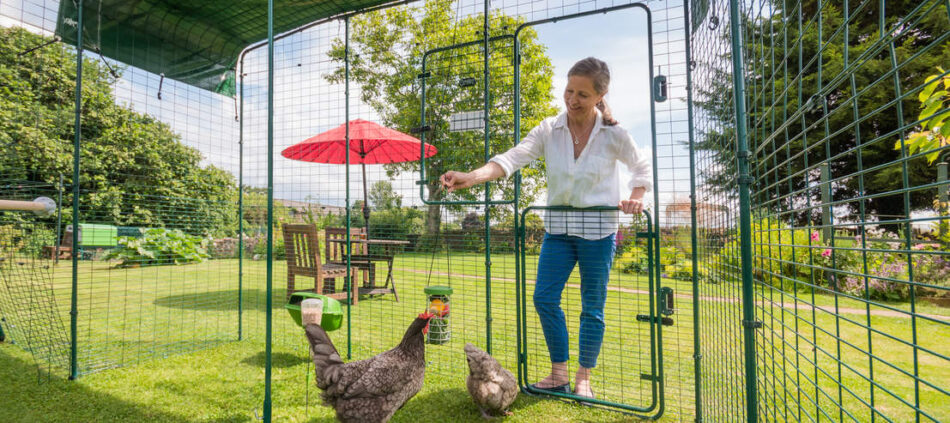
1. You have created a social media page for your Hens
Let’s face it, when you invest in a chicken coop and purchase your first flock you have to share it with friends and family. Whether it is documenting first eggs laid in the coop to your gourmet recipes with your farm-fresh eggs you are posting it on Instagram, Facebook, or Twitter.
2. You find eggs throughout the house
As you start becoming more comfortable with your chickens maybe you decide to let them into your home. They never bother anybody and get along great with your other pets but occasionally you find a fresh egg in your fruit bowl or on top of your favourite armchair. Hey, at least you know they are comfortable!
3. A “staycation” is your idea of a holiday
When you invest in your first brood you feel like you are a second parent to these animals. You wash them, feed them, and make sure they are comfortable. Add that in with taking care of your own kids and the idea of going on holiday is the last thing on your mind. You would much rather set up a zoom background of the beach or the tropics, order in a favourite meal, and put your feet up. Ahhh!
4. You find yourself chatting with your chickens
Sometimes we just need a good therapy session with an attentive listener, and who better than your chickens. They will never talk back to you or judge you for your decisions. They may give the occasional nudge or peck for a pet but hey, it is cheaper than therapy.
5. You have pet names for your hens
After the first couple weeks of tending to your chickens you start noticing some have different personalities. Some are on the shy side, some are very particular about their feeding time, and some just want all of the cuddles in the world. What a perfect time to give them a name! Whether it is Rudy, Cleo, or Fluffy we don’t judge here because they are your pets.
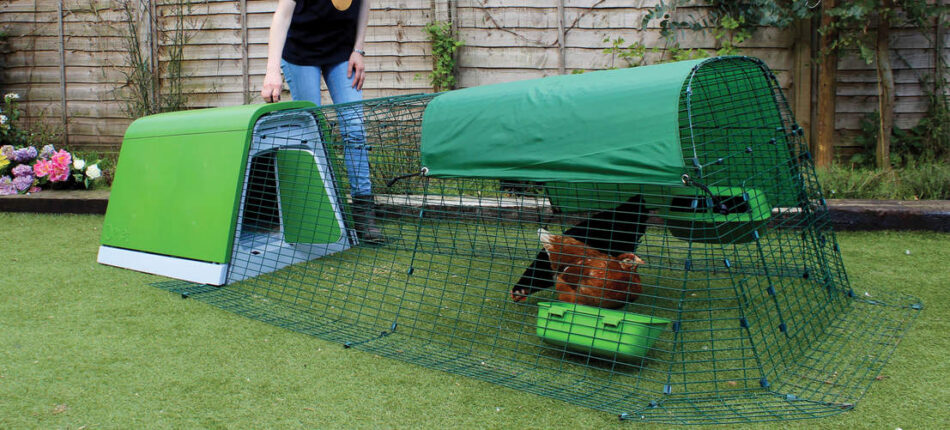
6. The home is filled with fashionable fowl décor
Whether it is chicken cocktail napkins or a hen-tastic serving platter you or your friends have made sure that you have all of the latest in chicken-related home furnishings.
7. You have a carrier bag to transport your chickens
Maybe you need to take them to the vet like any of your other pets. Who says that they shouldn’t be comfortable? That is why you have the top of the line carrier to transport your chickens whenever they are unwell.
8. Dressing up your brood for special occasions
When you have spring chickens or fall fowls they must be dressed for the season. When Halloween comes around you wouldn’t put it past yourself to dress up your chickens in a matching outfit with your other pets.
9. Instead of walking the dog you find yourself walking the flock
Yes, there are harnesses for chickens because you have already researched it on Amazon. Maybe you have limited land and your chickens need to stretch their legs each day, so you take them to the local park to graze and get some fresh air. Totally normal, right?!
10. You find yourself building a chicken picnic table for feeding time
We have all seen the trend of building mini picnic tables for our squirrel friends in our backyard. If you haven’t just Google it and you will be entertained by these structures. Well, who says your chickens should have any less than the squirrels. You paint your own table to pour your chicken feed into each day so your chickens can chow down in style.
At the end of the day, we understand that when you decide to venture out into the land of chicken coops it can be a daunting process. Everyone has unique experiences and should be able to tend to their hens/ roosters in their own way. Your flock is part of your family so why skimp on their care and upkeep!
This entry was posted in Chickens on September 30th, 2020 by linnearask
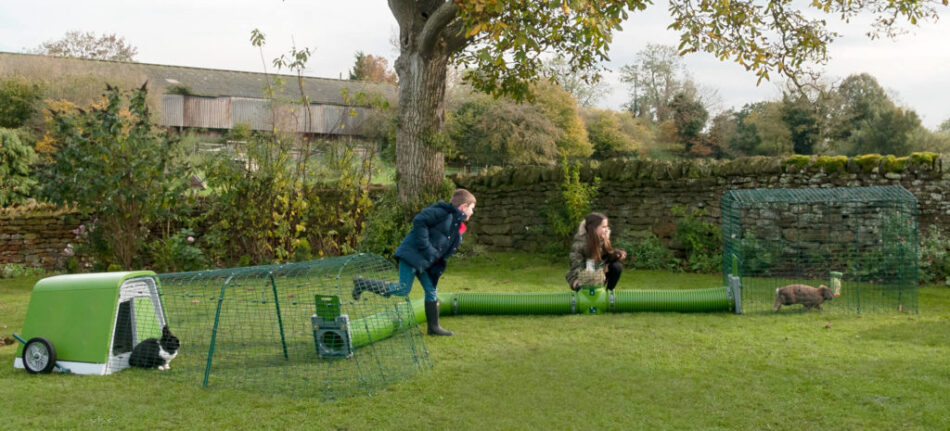
Autumn is the perfect opportunity to take some time to make sure your bunnies are happy with their setup in the garden. After a scorching summer, the more comfortable temperatures of autumn will be warmly welcomed by us and our floppy-eared friends. The change in season brings a cooler breeze, beautiful crisp leaves, and plenty more exciting sights and smells for bunnies to explore around their homes. Before the real winter chill hits, now is the perfect time to upgrade your rabbit run. So, how exactly can you transform your pet’s summer hideaway to a cosy rabbit retreat?
Extensions
First of all, take a good look at your run and assess if it is good enough for your beloved bunnies, or if there is room for improvement. Whether they have an Eglu Run, Outdoor Rabbit Run or Zippi Run, you can make it larger with practical and easily assembled extension panels. That way your bunnies have more space to run around on, and you can add more fun accessories that will keep them busy in the colder months.
Caddi
Leftover food and treats lying around the run not only makes it look a bit sad and untidy, it can also attract rodents and other pests, and if you’re not vigilant with your cleaning your rabbits might accidentally ingest something that has gone mouldy.
A great way of upgrading your run, and feeding your pets yummy and nutritious treats, is to get a Caddi Treat Holder. Fill it with fresh grass, allotment veg or some chopped up fruit, and hang from the top of the run. The rabbits will love the swinging motion of the holder as they try to grab a delicious mouthful, and the spillage will be minimal. Additionally, you will be able to keep track of when you gave your rabbits which treats, so you can alternate between different ones and make sure nothing that has gone off is still in the run.
Platforms
Everyone knows that rabbits love to hop! Adding platforms to your rabbit’s run is a great way to let your rabbit bounce to their heart’s content, whilst you make the most of the usable space that you have in their Zippi Run. Platforms will provide your fluffy friend with more places to explore, which in turn will help to strengthen their muscles as they jump up and down on their new adventure playground. The Omlet platforms are also suitable for use all year round, so you can still get the most out of this feature for when the weather gets cooler over autumn.
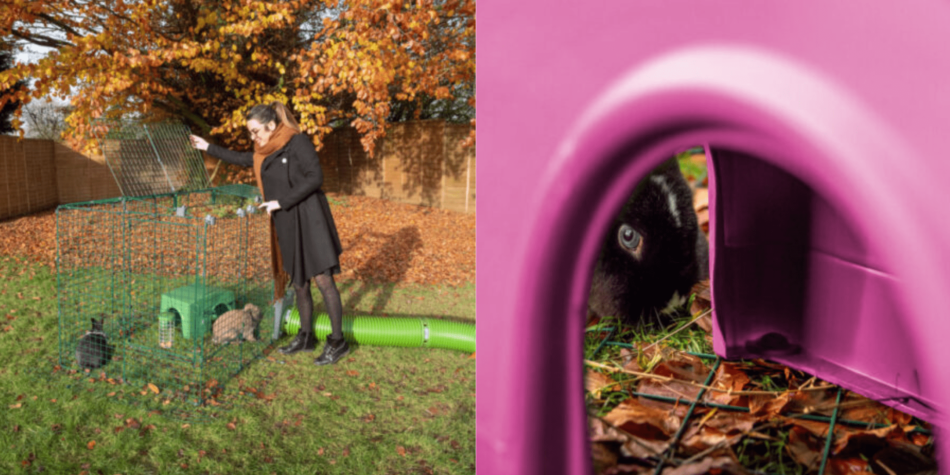
Shelters
The Zippi Shelters will be a great addition to your run this autumn, as they provide both (surprise surprise) shelter and an invitation to stimulating play. Rabbits have a natural instinct to seek a hidey hole, and in the wild they create ‘rooms’ in their warrens where they can come to relax and have a nap. The Zippi Shelters will provide exactly this, but in your pet rabbits’ run. They will also love running in and out of, or jumping on top of the Shelter to survey their surroundings.
Although the rabbits will always have their hutch to retreat to when it gets wet or windy, it’s great to have another spot where they can get away from the inevitable autumn showers. The shelters are sturdy and waterproof, and your rabbits will love hopping in to relax.
Treats
As it gets colder your rabbits will use more energy to stay warm, so it’s the ideal time to stock up on treats for the cupboard. Make sure you find a good balance between fresh fruit and veg and shop bought treats to put on the run, like these Nettle and Dandelion roots that are full of vitamins and minerals, or the Beaphar Crunch Sticks that encourage healthy dental wear.
For more inspiration and ideas on how you can improve your rabbit’s autumn setup, take a read of our 8 Tips for Making Your Pets’ Run More Fun This Autumn blog. And to make sure your bunny has everything they need to make this special season amazing, discover everything the Omlet Rabbit Shop has to offer.
This entry was posted in Rabbits on September 24th, 2020 by linnearask
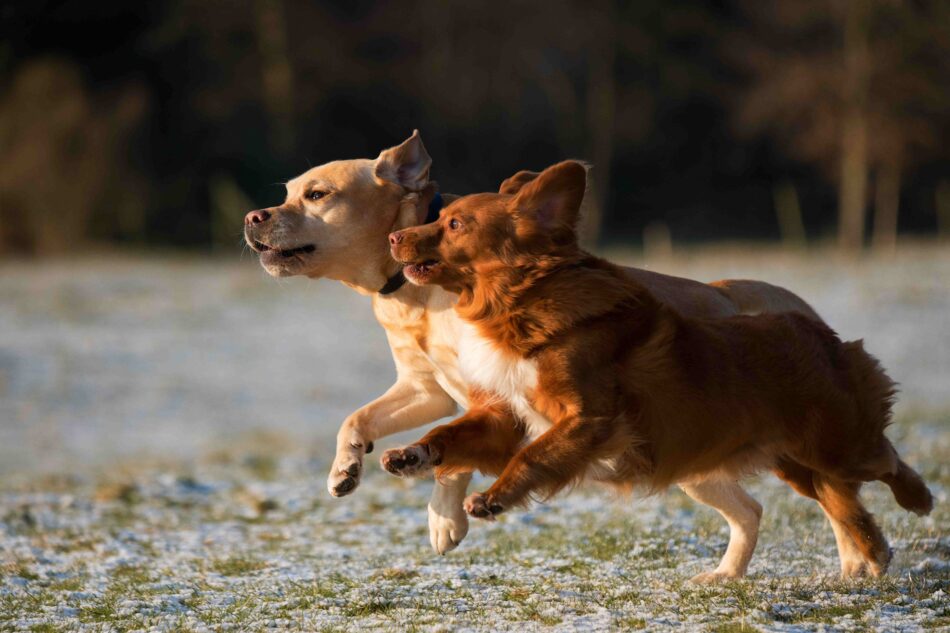
Playdates for dogs are an increasingly popular calendar fixture for dog owners. The fact that these most sociable of animals like to socialise should not come as a great surprise. But there is, of course, far more to a successful get-together than simply unleashing a kennelful of canines into your back garden!
Our ten tips will help ensure that your pooch party goes with a woof rather than a snarl.
1. Don’t Invite Enemies!
The guest list is possibly the most obvious party-success factor of them all, but it is one that often gets ignored. For example, your friend might have a Jack Russell that your Labradoodle simply hates. And yet inviting your friends and their dogs is an obvious thing to do when arranging a doggy date. A territorial or bad-tempered dog that doesn’t get along with your pet is not going to be the life and soul of your doggy date. And, of course, your own dog needs to be a sociable hound host, too.
2. Avoid Chalk-and-Cheese Syndrome
Dogs tend to play best with friends of their own size and of a similar age. An older dog doesn’t want to be harassed by a bunch of excitable puppies, and a small terrier doesn’t always want to be stalked by an enthusiastic pack of Retrievers. An overweight or arthritic dog may suffer, too – they may want to keep up with the others, so as not to miss out on the fun, which may result in more harm than good.
The exception to the chalk-and-cheese rule is when dogs already know each other. If you know they’re friends already, invite them – although you still need to watch out for the reactions of the other guests.
3. Keep the Numbers Down
The difference between a happy group of dogs and a rowdy pack is a fine line. As a rule of thumb, keep the number of dogs to six or below on a doggy date, to keep things under control.
4. Invite Humans Too!
A doggy date isn’t an excuse for owners to leave their dogs in a crèche for a couple of hours. It only works if the owners are present; and an owner who brings more than one dog should, ideally, bring more than one human too.
5. Make Sure the Space is Suitable
There are all kinds of places you can hold a doggy playdate, whether indoors or outdoors, and the guest list should match the space. Six Huskies in a kitchen isn’t going to work, and open gates or gaps in a fence are just asking for trouble. You will also need to dog-proof the room or the garden, removing access to anything that’s fragile, toxic, edible or out-of-bounds for whatever other reason. The host dog and its guests should not have their own toys or bones lying around, either – all available toys should be neutral. If the host dog is very territorial, it simply isn’t going to work unless you arrange the playdate in a neutral space.
6. Meet and Greet
The dogs should all be formally introduced before the doggy date begins, even if they have met before. Owners should have their pets on a lead, and the dogs should be made to sit, in a semicircle so they can all see each other. They can then mingle on loose leads. Only when everything is looking sociable should the dogs be let off the lead completely. Any dissenters will have to be kept on a lead until they get into the spirit of the party. If, for whatever reason, one of the doggy guests falls out with another, it should be led quietly away on a lead until the situation has calmed down.
7. Allow Downtime
Some dogs have more energy, patience or bravery than others. On a doggy date, it always helps to have a hidey hole where a dog that needs to catch its breath can take time out. For smaller dogs, this can be the owner’s arms. Larger dogs will need a quiet corner, indoors or out. In a larger garden, they will be able to find their own space to chill. Dogs are very good at body language, and the others will recognise that the resting dog is doing just that, and not playing hide and seek.
8. Provide Refreshments
Busy dogs will need to drink, so one or more drinking bowls is essential. A supply of treats will keep the edge off their appetites, too.
9. Play Some Party Games
Games of fetch, hide and seek, sit and wait, agility tests or obstacle courses are all great ways to keep the party happy and active. Treats can be used as prizes!
10. Avoid Too Much Sun
If it’s a really hot day, an outdoor doggy date will needs lots of shade, lots of water and should involve only the very fittest dogs. Heat can be a health hazard for weaker animals. Remember – you can always postpone.
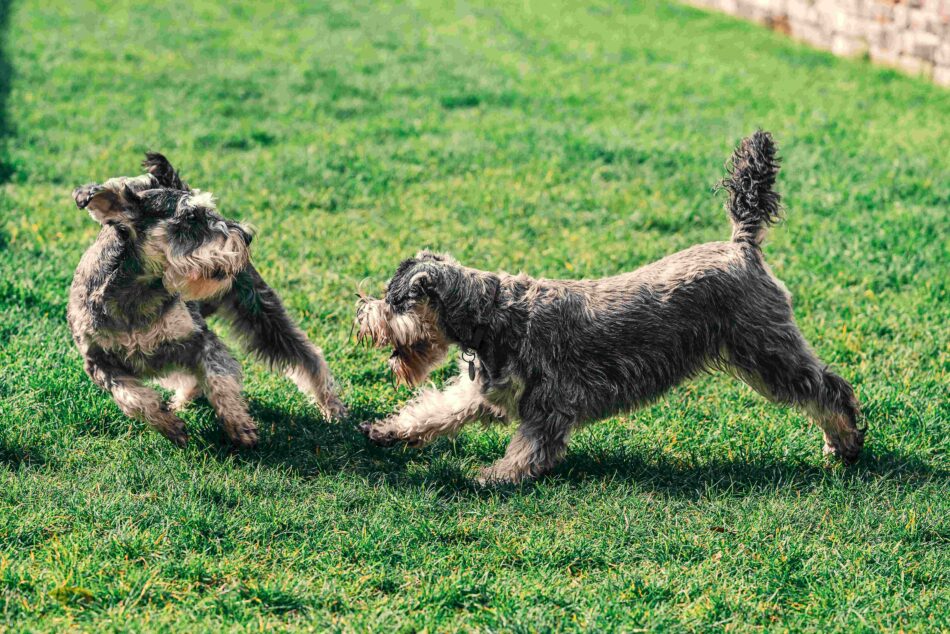
This entry was posted in Dogs on September 21st, 2020 by linnearask
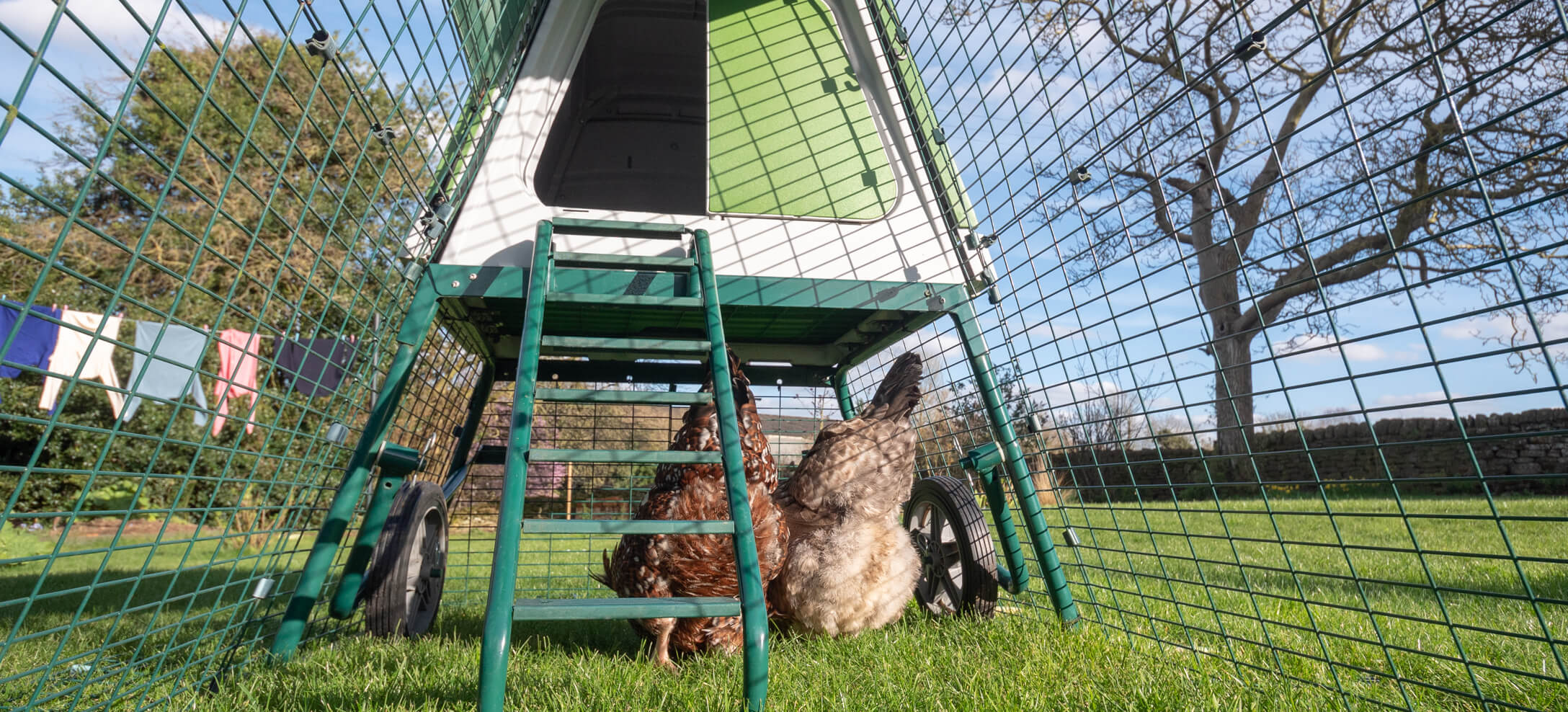
Like most other animals, chickens can suffer from parasitic worms. These are endoparasites that live inside your bird’s body, and are collectively called Helminths by vets.
Does my chicken have worms?
The three types of parasitic worms that your chickens are most likely to contract are:
- Roundworms. There are a number of different roundworms, with the large roundworm being the most common. They live anywhere in the bird’s digestive system, and can sometimes be spotted in your chickens’ droppings.
- Gapeworms. These nasty parasites attach themselves to the trachea of the chicken, hooking on without moving.
- Tapeworms. These attach themselves to the lining of the intestine and can get really long and unpleasant. They are less common, but will more significantly affect the bird.
It’s not always straightforward to tell if your chicken has worms, but symptoms may include a paler comb, decreased egg production, diarrhoea and increased appetite without weight gain. A chicken who has been infected with gapeworm will stretch their neck and gasp for air. Sometimes you won’t spot an infection until it’s really serious and possibly untreatable.
To worm or not to worm
Many chicken keepers therefore choose to worm their chickens regularly to prevent them getting infected, usually once in spring and once in autumn. This is normally done using Flubenvet, a poultry specific wormer you can get at the vets that will kill both the worms and their eggs. Make sure you get a worming treatment that is suitable for chickens, and check if you should be discarding the chicken’s eggs while she is being treated. Always worm all chickens at the same time.
Other chicken keepers think it’s better to only treat chickens that have a confirmed infection. This is partly because some wormers are only effective on particular parasites, and will be pointless if your chickens have a different type of worm. Some also think it’s unnecessary to stress the system by giving the birds treatment for an issue they might not have. Additionally, it can be pricey to worm a whole flock twice a year.
If you don’t want to treat your chickens without a diagnosis, but suspect they might have worms, you can get their droppings tested for presence of eggs. Ask your vet if they will do it for you, or you can send the droppings off to a laboratory in pre-made kits.
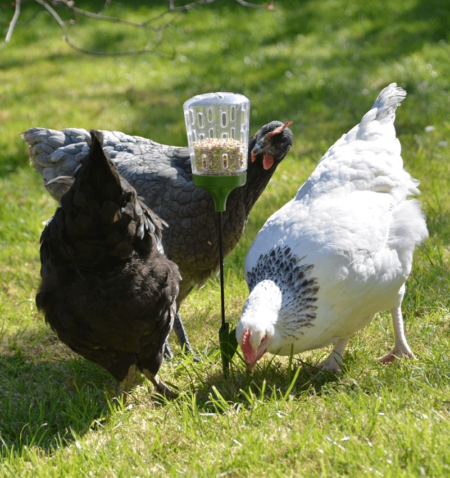 Prevent infections
Prevent infections
Whether you decide to treat only confirmed worm cases or worm preventatively, it’s always best to do everything you can to make sure your chickens don’t contract parasites.
One of the best things to do is to regularly move their coop and run to a new patch. This will stop serious outbreaks, as it stops the life-cycle of the worms. Worm eggs are expelled in the droppings from infected birds, and survive on the ground for a surprisingly long time before they are picked up by foraging chickens. This is called a direct life-cycle, as the worm doesn’t need a host animal to get to your hens. Worms that have an indirect life-cycle on the other hand let their eggs first be ingested by for example earthworms, slugs or centipedes, where they lay dormant until the host is eaten by one of your chickens. The larvae hatch inside your hens, and the cycle repeats.
To prevent an unbreakable chain of worm infestations, it’s therefore important to regularly move your chickens. This is made easy by portable chicken coops like the Eglu Cube or the Eglu Go UP.
Another useful thing is to keep the grass mowed as the ultraviolet light from the sun can kill off potential worm eggs in your chickens’ droppings. Clean the run every week and scoop up droppings and wet bedding. If one of your chickens is infected it’ll be very difficult to get rid of all worm eggs from the ground, but every little helps!
Finally, many chicken keepers swear by the mineral supplement Verm-X. It’s a herbal formulation that works to create an environment in the gut that is able to eradicate and expel any intestinal challenges. This can be given as a supplement to your flock regularly to help their immune system stay on top.
This entry was posted in Chickens on September 18th, 2020 by linnearask

There are five hamster species commonly kept as pets. They are all similar in their requirements, but with one or two important differences between species.
The most familiar is the Golden, or Syrian hamster, which is also the largest of the five. The others are all in the group known as Dwarf hamsters – Campbell’s, Roborovski, Chinese and Winter White.
Looking After a Golden Hamster
An estimated 75% of pet hamsters are Syrians, largely because they have been popular for many years, and are therefore widely available. This species is 15–18 cm (6–7 inches) long, and is relatively slow moving (compared to the much nippier Dwarf species). This makes them easy to handle, and that’s one of the keys to their popularity. A nervous owner will find handling very easy (i.e. the hamster isn’t going to run up your sleeve or make a bolt for the door before you can stop it!)
The Golden is a loner, and that means its owner will be its only companion – which is great for forming owner–pet bonds. The hamster will usually live for 2 to 2 ½ years, and can be hand-tamed from a very early age, so you will usually have a long and satisfying friendship with these little bundles of fun.
There are a different types of Golden hamster. One of the most popular is the long-haired ‘Teddy Bear’. There are also different colour varieties, with mixtures of gold, brown, russet, yellow, grey, black and white.
IDEAL FOR: first time hamster owners looking for a single, easy-going pet that’s easy to handle.
Looking After a Chinese Hamster
The Chinese – also known as the Striped, Grey or Rat-tailed – is the least common of the hamsters in the pet trade, although its popularity is growing all the time. There’s a lot to love in these little characters – they are very gentle, and once hand-tamed they will love their daily human interaction.
This species grows to a length of between 10 and 13 cm (4–5 inches) inches and, and is dark grey with a darker stripe running down the back. It has a long tail, by hamster standards, hence the ‘Rat-tailed’ tag. It tends to live a little longer than the Golden hamster, with a lifespan of 2 ½ to 3 years, and like the Golden it likes to live alone. This makes it bond very readily with a human companion.
IDEAL FOR: first time owners, or owners looking for something a little less common than the Golden, but with a similar personality.
Looking After a Roborovski Hamster
This is a lively little pet, and likes to live with at least one other fellow Roborovski – in a same-sex pair or small group. Single animals will do just fine, though, as long as they get lots of human company and handling. They are 10 cm (4 inches) long, and are endlessly curious about the world around them. When handling, you need to be alert, as these are fast movers.
Roborovskis are long-lived, by hamster standards, generally lasting between 3 and 3 ½ years. Being keen climbers and explorers, they will need a cage large enough to accommodate their endless expeditions, so space is sometimes an issue for would-be owners. They also have a rather strong smell, so they need cleaning out very regularly.
IDEAL FOR: owners who want to keep more than one hamster at a time, and have space for a larger cage.
Looking After a Winter White Hamster
This species is also called the Siberian, due to its wonderful colour change during the winter. It is grey-brown for much of the year, with a handsome black stripe down its back. In winter the fur becomes white, but the black stripe remains.
This little character reaches just over 10cm (4 inches) in length, and can live alone very happily, making it a good pet for someone who has lots of time to handle and bond with their pet, and who isn’t nervous handling a fast-moving, small animal. Winter Whites only live 1 ½ to 2 years, and this makes them less popular than some of the other species.
IDEAL FOR: hamster lovers looking for a change from the commoner species, and who can’t wait to see that wonderful change to wintry white!
Looking After a Campbell’s Hamster
This is another short-lived hamster, with a lifespan of 1 ½ to 2 years. They are usually kept in same-sex pairs or groups, but can thrive as singletons as long as they get lots of handling and attention from their owner. Their small size makes them tricky to handle, being both swift and fragile, so they are not suitable for young or nervous owners.
IDEAL FOR: owners who want to keep a group of hamsters together in a larger cage.
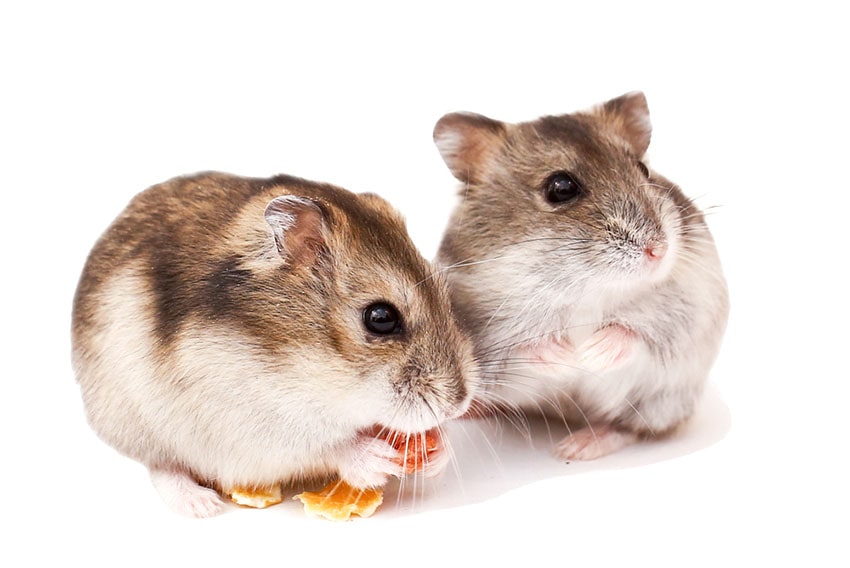
This entry was posted in Hamsters on September 18th, 2020 by linnearask

Take this opportunity to get some good quality feed that will keep your chickens happy and healthy this autumn! When you sign up to the Omlet Newsletter on this page (for the feed) or this page (for the Easichick Bedding), you will receive a unique promo code that gives you free delivery on your feed or bedding – for a limited time only!
The offer is available on your pick of two bags of Omlet’s Organic Chicken Feed, Omlet’s Organic Mixed Corn, Organic Omlet Chicken Feed 10kg and Mixed Corn 10kg or Organic Omlet Chicken Feed 10kg Twin Pack, or two bags of Easichick Bedding!
Terms and conditions
This promotion is valid while stocks last, until midnight 05/11/20. Once you have entered your email address on the website you will receive a unique discount code that can be used at checkout. By entering your email you agree to receive the Omlet Newsletter. You can unsubscribe at any point. The offer of free delivery is available on Omlet’s Organic Chicken Feed, Omlet’s Organic Mixed Corn, Organic Omlet Chicken Feed 10kg and Mixed Corn 10kg and Organic Omlet Chicken Feed 10kg Twin Pack, or Easichick Bedding. The offer does not include any non-Omlet branded feed. Excludes grit. Excludes any other type of bedding. Offer is limited to 2 bags of feed per household, or 2 bags of Easichick. Free delivery only applies to the included products, delivery charges will be added for other items added to the order. Free delivery offer is not redeemable on pallet deliveries. Omlet cannot take responsibility for third party supplier delays such as courier service. Free delivery is only valid for orders sent to mainland UK, and only applies to Standard Delivery Service. Subject to availability. Omlet ltd. reserves the right to withdraw the offer at any point. Offer cannot be used on existing discounts or in conjunction with any other offer.
This entry was posted in Chickens on September 15th, 2020 by linnearask
Making sure your flock is healthy and happy is the responsibility of all chicken keepers. Knowing how to give your chicken a health check will enable you to see that all of your hens are feeling their healthiest. When combined with adequate shelter, nutrition, and enrichment, regular health checks will help your chickens live long, healthy lives. Learn when and how to give your chickens health checks, and familiarise yourself with what’s normal so that you can recognise when something is amiss.

Why are chicken health checks important?
Like other pets, injuries and illness can occur in chickens. Since chickens are prey animals, they are masters at hiding pain and weakness. So while some illness or injuries may seem to occur suddenly to the untrained eye, there may be subtle hints that can be detected through routine health checks.
Routine chicken health checks will also give you a baseline for what’s “normal” for each individual hen. By knowing how your chickens normally look and feel, you’ll be able to more quickly identify a potential issue. Time is of the essence when your chickens are feeling “off” — making regular health checks a vital part of your flock-care routine.
How often should I give my chickens a health check?
It’s likely that you’ll observe your chickens daily as they go about their business in the yard or run. But weekly chicken beak-to-tail health checks are best for heading off potential problems. Each week, handle your hens and go through this checklist:
Eyes
Your chicken’s eyes should be clear, bright and fully open. Any amount of discharge, whether clear and watery or thick and yellow or green, is abnormal. Their eyes should also be properly lubricated and not appear dry, and third eyelids should slide easily and retract fully.
Nose
Nostrils, or nares as they are called in chickens, are located on the top of the beak near the eyes. Nares should be clean and free from debris, and should not have any discharge. Breathing sounds should not be audible.
Beak
Your chicken’s beak should be smooth, without cracks or other damage. The top and bottom should align, with the top being slightly longer. Healthy chickens keep their beak closed most of the time.
Comb
A grown chicken who is not broody or moulting should have a firm, bright red comb. It should be positioned according to the breed standard, i.e. if the breed’s comb is upright, it should not be hanging or looking shrivelled.
It’s especially important to check combs and wattles in winter, as they are prone to frostbite. Larger combs can be protected by a daily layer of vaseline.
Crop
Chickens have a “crop” at the base of their esophagus that holds their food before it’s moved through the rest of their digestive system. You can feel the crop by palpating by the breastbone of your chicken at the base of their neck. It’s easiest to feel when your chicken has just eaten — it will feel firm and about the size of a golf ball. Empty crops usually can’t be felt.
When you first let your chickens out in the morning their crops should be empty, as they should have spent all night digesting their food. After eating, the crop will feel firm, but not rock-hard. If it never feels empty, full even after not having food all night, or if your hen’s breath is foul smelling, you could be dealing with an impacted or sour crop.
Feathers
With the exception of molting season in chickens, your hens’ plumage should be full and shiny. Bald patches, broken feather shafts, or unkept feathers can all be signs of stress, parasites, or behavioural concerns.
Legs and feet
Your chicken’s legs should appear smooth, with the scales lying flat against the bone — raised or dry scales can be an indication of scaly leg mites. The bottoms of the feet should be smooth and free of cuts, discoloured spots, or bumps. Large bumps on the bottoms of the feet can indicate bumblefoot in chickens, which is a bacterial infection.
Vent
The vent, or cloaca, of chickens is where eggs and eliminations are expelled from the hen’s body. Laying-age hens have pink, wide, and moist vents, while vents in older hens may appear dry and more pale. Healthy vents should never protrude or appear injured. Mites and lice gravitate toward this area, so check for black specks of debris or skin irritation.
Droppings
Slide out dropping trays, like those on Eglu chicken coops, help you keep an eye on your flocks eliminations. Chicken droppings should be formed and somewhat firm, and dark brown in colour. Loose, white portions on these droppings are also normal. Your chickens’ droppings will vary depending on their diet for the day, but should always revert back to “normal” within a day or two of eating new or diverse foods. Extended periods of loose stool, or bloody stool is an indication of illness or stress.
What to do if your chickens aren’t feeling their best
If any of your findings during the chicken health check are abnormal, it’s best to separate the affected hen from the rest of the flock and contact your veterinarian for further guidance. Make sure that you have a veterinarian that treats poultry as a point of contact. Some veterinarians may be able to come to you, or give you advice over the phone on how to proceed with any chickens that feel under the weather or that appear injured.
Isolate ill or injured hens until their symptoms have cleared, or until you’re advised by your veterinarian that it’s ok to reintroduce them back into the flock. Having a back up chicken coop to serve as a hospital wing or quarantine coop is always a good idea. This will ensure that the chickens that any chickens that aren’t feeling their best will still be housed in the best accommodations possible — which will help aid in reducing their stress and boosting their recovery.
Omlet and your healthy hens
A healthy flock starts with their housing and care. Our chicken coops are easy to clean, and offer the support and security that your flock needs. When they’re not sleeping or laying eggs in their coop, your hens will enjoy their time outside safely inside our walk in chicken runs, protected from predators. Add chicken run weather covers, and your flock will be ready to enjoy healthy, happy seasons in their home with you.
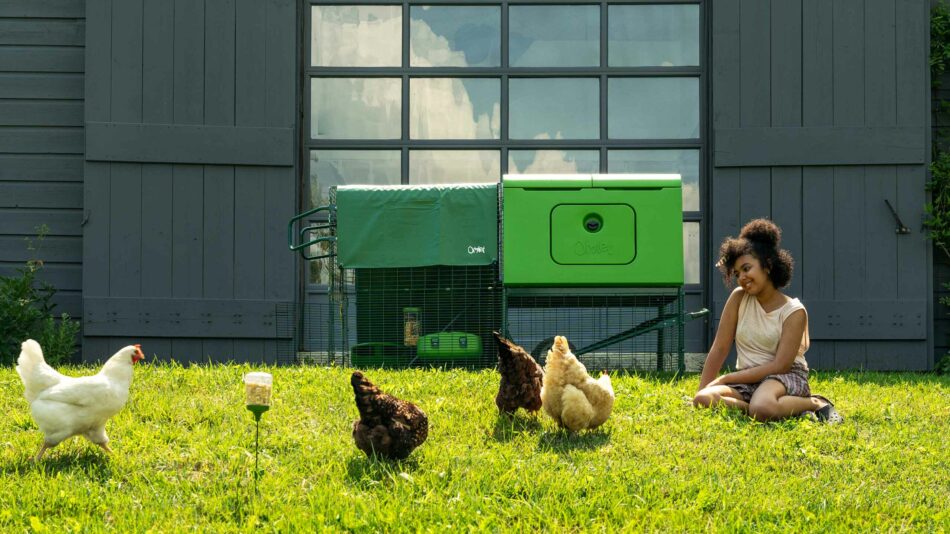

This entry was posted in Chickens on September 14th, 2020 by linnearask







 Prevent infections
Prevent infections




